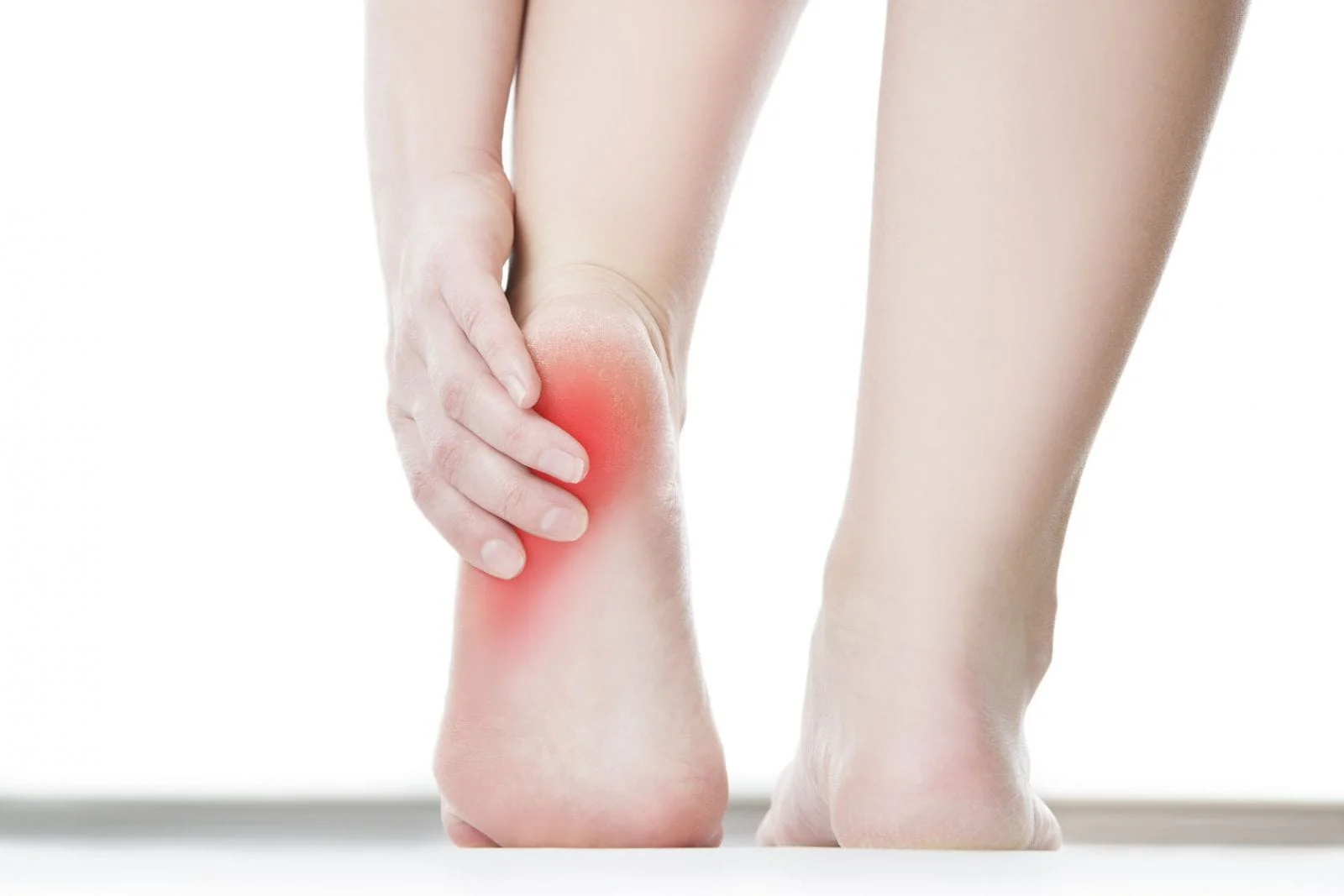Heel Pain is one of the most common problems I see in my office every day. My goal is to help you kick that pain to the curb where it belongs and get you back on your feet doing the things you love!

Keep in mind that pain of any kind is not normal. Pain is our body's way of telling us something is wrong. If you are experiencing foot or heel pain that won’t go away, don’t just ignore it. Take steps to educate yourself about treatment options and make it a priority to address the root cause of your pain. You deserve to have a body that is healthy and free from pain!
This page is devoted to helping you understand typical symptoms and the wide range of treatment options that are available to you.
Typical Symptoms-Does this sound familiar?
Here are some of the most common things I hear from patients about heel pain; tell me if any of these sound familiar:
“The first step of the morning is the most painful!”
“Painful needles poke me every time I take a step!”
“My heel aches all day long, whether I am on my feet or not.”
“I’ve had pain for awhile, but it just keeps getting worse.”
The types of symptoms listed above are common with a condition known as Plantar Fasciitis (PLAN-ter fash-ee-EYE-tus), which occurs when the ligament that connects your heel bone to your toes becomes inflamed. If you are suffering with these types of symptoms, or something similar, there is help available!
Conservative Treatment Options
Whenever I have patients who come to me with symptoms typical of plantar fasciitis, or “heel spur syndrome” as it is sometimes known as, I recommend conservative treatment options first. Many of my patients are able to find the relief they need at home, without any type of advanced intervention. Let’s take a look at some options available to you for combatting your heel pain at home right now:
- Stretch, stretch, stretch. I know it seems almost too simple to work on your pain, but I think we too often underestimate its benefits. Studies have shown how significant stretching can be in improving plantar fasciitis. Check out the videos below for my recommendations on the best stretches for alleviating heel pain. One major advantage to this treatment is that its free! Try it out today!
- Massage. This can be one of the very best conservative treatments for your plantar fasciitis. Similar to stretching, this treatment option is free and can be done in the comfort of your own home. See the demonstration videos below for the best placement and techniques to target your heel pain most effectively.
- Ice. This treatment option can provide you with fast relief and can be incredibly cost effective. My recommendation is to freeze a bottle of water and just roll your foot gently along the bottle of water. As with any icing regimen, take care not to apply ice for too long. When you are done, just pop the bottle back in the freezer & you can re-use it over and over again as needed.
- Support. The shoes you wear make a huge difference in the overall health of your feet. Have you checked out our Patient Education section here on the website for information on shoes? We cover a variety of topics from what to look for in athletic shoes to shoes for men, women, and children. Spend a little time reading up and choose your next pair of shoes wisely.

With these conservative treatment options, you should find some, if not total, relief from your plantar fasciitis symptoms. If your pain still persists however, there are several more advanced treatment methods available. The options below are methods used in my office daily to help my patients recover from heel pain:
- Strapping. In the office I use a special tape & taping method that limits abnormal movement and provides more support to the plantar fascia. Many patients comment on how immediate the improvement in pain can be in this simple but effective method of treating heel pain.
- Orthotics. Orthotics are shoe inserts that provide structural support to the foot & and can reduce pain from plantar fasciitis significantly. There are a variety of orthotics available and many different price points.
- Prefabricated: These are the most cost effective shoe inserts and are available over-the-counter at several retailers, and also in our office. Be aware when choosing a prefabricated orthotic that there are several different types and styles and the most supportive insert will be rigid and firm with a deep heel cup. The brand I recommend most to my patients is Superfeet. We carry the styles of this brand that I feel are most supportive in several sizes in our office, including for children. The benefits of this type of orthotic are the low cost, non-invasive nature of the treatment, and how fast these can be obtained relative to custom orthotics because they are over-the-counter. The drawbacks to this type of insert include the limited durability as most pairs will eventually need to be replaced and quality. Because this type of insert is prefabricated, it may not be formed to specifically target the areas you need help with.
- Custom: I recommend custom orthotics to all my patients suffering with heel pain because I think they can be one of the most effective non-invasive treatments available. Custom orthotics are specifically created to give you individualized correction of your biomechanical anomalies & are designed to provide relief of your specific underlying and associated musculoskeletal issues. The custom orthotic process begins with an initial casting appointment. During this visit I will use plaster to make an image of each of your feet with any specific added corrections which will be used to design your custom orthotics. Once the mold has been created, we send it to our manufacturing facility where your insert is designed & created specifically for you. After your custom orthotics have been designed & manufactured, you will be contacted to set up a fitting appointment. At this visit, you’ll receive your new inserts and I will work with you to ensure proper fit. Any adjustments that may need to be made are completed at that time. Orthotics usually require what is known as a “break in” period. I recommend wearing them for just an hour a day in the beginning and gradually working your way up to wearing them all day when you are on your feet. We’ve had tremendous success with treating heel pain with this method and I highly recommend it. The benefits are that you receive a long-lasting, durable solution to your specific problem as most pairs of custom orthotics should last at least a few decades, if not longer. Since the solution is molded to your specific foot design you should receive the relief you are looking for in a way unavailable with many other types of inserts. And this solution is non-invasive. The drawbacks to custom orthotics include the time it takes to design, manufacture, and deliver your custom orthotics is usually about 30 days. Additionally, custom orthotics have a higher price point, although many insurance companies do cover the cost of the orthotics and visits. If you would like to know if you insurance company covers the cost of custom orthotics, contact our office today and we would be happy to look into your eligibility and coverage for you.
- Injections. Anti-inflammatory medication can be injected into the plantar fascial region to reduce swelling and tenderness. It can be a painful treatment for some, but is usually effective in providing relief for patients for several months at a time.
- Night Splints. This is a brace generally worn at night to reduce “first step in the morning” pain. The device supports the foot in a “toe-up” position that allows the plantar fascia to remain gently stretched throughout the night, so your first step out of bed isn’t accompanied by pain. These also are often covered, at least partially, by insurance.
- Surgery. When all other options have been exhausted, there are surgical options for eliminating plantar fasciitis. A special procedure can be done to release the plantar fascia, eliminating the root cause of the pain. These cases are less common and are usually only considered when both conservative and advanced treatment options have been exhausted. The vast majority of heel pain sufferers can usually find the relief they are looking for through more conservative means of treatment.
- If you are suffering from heel pain, know that you don’t have to! We’ve discussed several options for both conservative and advanced treatments for your heel pain. For many patients, a mix of at-home and in-office heel pain treatments usually works to correct their plantar fasciitis. We hope you’ve found the information helpful for kicking your own heel pain! If you have questions, click her for an Appointment Request or call our office at 209-823-2700. We’re here to help Heel your Pain!
